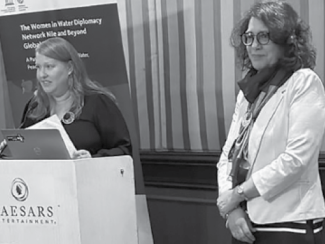ELI Report
Environmental peacebuilders convene in The Hague
In June, the Environmental Peacebuilding Association—EnPAx—convened the Third International Conference on Environmental Peacebuilding in The Hague. Co-hosted by the Grotius Center for International Legal Studies at Leiden University, the conference brought together over 400 leaders, practitioners, and researchers from 55 countries to expand the intersectional dialogue of this emerging field.
ELI supports the conference as part of its vision to shape the development of environmental governance across the world. ELI believes current governance systems must continually adapt to meet major environmental challenges, including climate change, environmental justice, and peacebuilding.
For over a quarter century, ELI has been at the forefront of research on the environmental consequences of war and the role of natural resource management in conflict resolution. As a “champion sponsor” of both the conference and the secretariat for EnPAx, ELI recognizes the value of peacebuilding to making law work for people, places, and the planet.
Founded in 2018, EnPAx is a multidisciplinary forum with three aims: foster knowledge development and exchange; build capacity and awareness; and strengthen relationships among scholars, practitioners, and decisionmakers working on issues related to environment, conflict, and peace, Membership bridges generations, locations, and disciplines; EnPAx now has over 450 individual members and 31 institutional members from 74 countries.
The conference boasted 75 sessions—panels, roundtables, workshops, and presentations—in addition to a full day of training sessions, workshops, and site visits.
Attendees helped shape the growing environmental peacebuilding field by developing an “Environmental Peacebuilding Glossary.” Participants provided insight to enhance the coherence and clarity of evolving terminology.
Through formal sessions and informal exchanges, the conference aspired to create space for connection, inspiration, restoration, and learning.
In the session on “Composing Peace: Music as a Tool for Environmental Peacebuilding,” participants drew from diverse experiences to collectively write and perform a song on shared hopes and insights about their work. Their song can be found on YouTube.
Annual workshop focuses on restoration and water quality
ELI hosted its 16th annual workshop on Section 303(d) of the Clean Water Act—which identifies waterbodies that do not meet water quality standards and supports their restoration and protection—at the National Conservation Training Center in Shepherdstown, West Virginia.
Held in June, this year’s workshop, titled Maximizing CWA Programs to Achieve Water Quality Goals, brought together nearly 200 program staff from 49 states, 5 territories, 13 tribes, all 10 EPA regions, and EPA headquarters, with more than 200 others participating virtually. The workshop, made possible through a cooperative agreement between ELI and the Environmental Protection Agency, provided an opportunity for participants to learn about and share approaches to various aspects of water quality assessment and plan development and implementation. Participants learned to use water quality data management tools; received updates on research, materials, tools, and legal developments; and expanded and improved their connections with other state, tribal, territorial, and EPA staff.
The workshop blended formal and informal learning. Formal learning occurred through presentations and facilitated discussion in breakout and plenary sessions, while informal learning took place at roundtable discussions, regional coffee chats, office hours, meals, and the campfire. The workshop covered a wide range of topics, including developing Total Maximum Daily Loads in ways that lead to more seamless collaboration and implementation, tools and approaches for using continuous monitoring data, environmental justice in monitoring and assessment, tribal water quality assessment, participatory science, emerging contaminants and toxics, how to answer common questions with available data tools, and program resilience and continuity despite staff changes.
The workshop was well-received, earning high marks in evaluations and, more importantly, yielding participants returning to their offices with new ideas and skills, a better understanding of available tools and resources, a national network of peers and mentors across the country, and rejuvenated inspiration.
Sustainability resource for local governments addresses food
State and local governments, as well as local NGOs, businesses, and communities, play key roles in implementing environmental laws and advancing climate change mitigation and adaptation. ELI’s Center for State and Local Governance is dedicated to supporting these programs by developing model governance tools and resources based on extensive best practices research. The center’s toolkits, ordinances, and guides are designed to be tailored to meet the needs and interests of a wide range of local and state contexts.
The center, in partnership with Natural Resources Defense Council, recently published a new ordinance as part of the Food Waste Initiative. The Model Municipal Zoning Ordinance on Community Composting is designed to advance community composting by establishing it as a permissible land use under a municipality’s zoning code—thus helping localities meet their climate and waste reduction goals while achieving various other co-benefits. By diverting organic waste from landfills and incinerators, composting reduces emissions of GHGs—particularly methane. Community composting is also designed to meet local needs and engage the community in various ways, including education on sustainability and local jobs.
Unfortunately, zoning can be an unintended barrier for community composters, sometimes unnecessarily preventing or restricting the siting of community composting facilities. This model ordinance aims to help municipalities remove this barrier by providing clean, off-the-shelf legal language to establish and govern community composting as a permissible land use across five basic zoning district categories. Where applicable, the model also requires that community composting be included in a municipality’s comprehensive or master plan to help secure its place in official visions for the municipality’s future.
In addition to adding community composting centers, cities can also reduce their carbon footprint by accounting for food-related greenhouse gas emissions and including food-related actions in their climate action plans, or CAPs.
The center’s Toolkit for Incorporating Plant-Based Protein Measures in Municipal Climate Action Plans offers one way for municipalities to do so. Given their low carbon footprint, plant-based proteins can play a significant role in reducing food-related emissions.
By including CAP actions that can increase the availability of plant-based proteins and engage the public on their benefits, municipalities can reduce food-related emissions while also realizing numerous co-benefits in the areas of public health, expanded consumer choice, environment, resilience and food security, equity, animal welfare, and cost savings.
ELI helps sponsor gathering of peacebuilders in The Hague.


